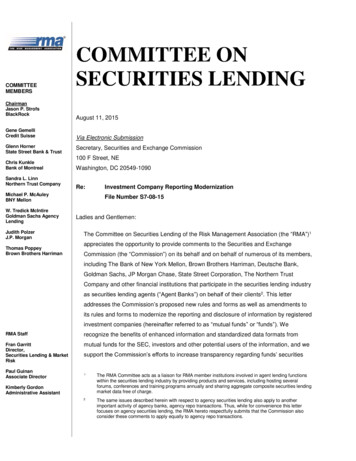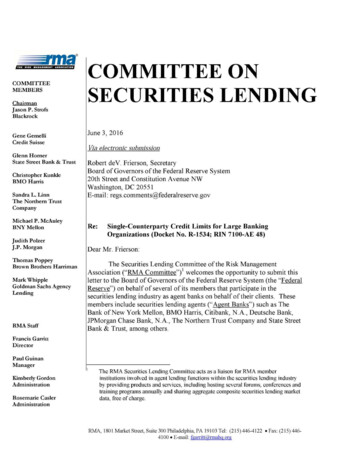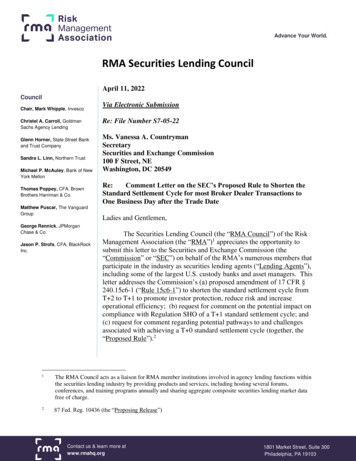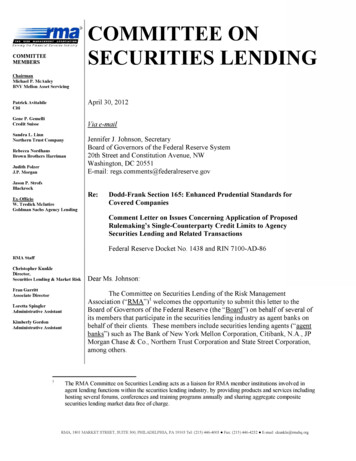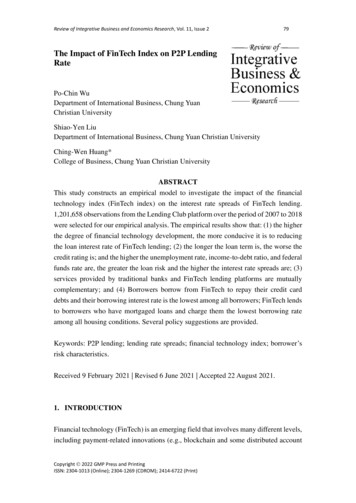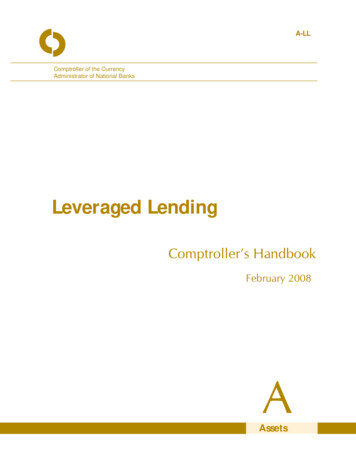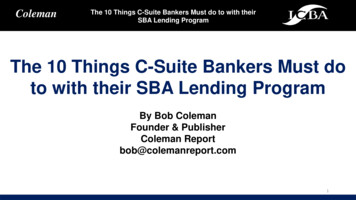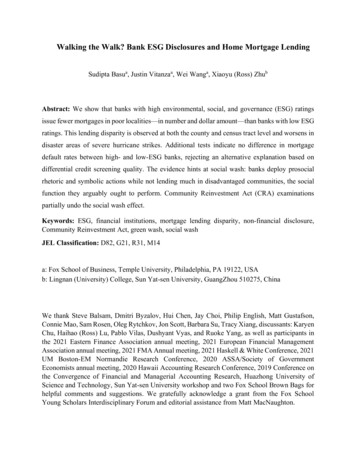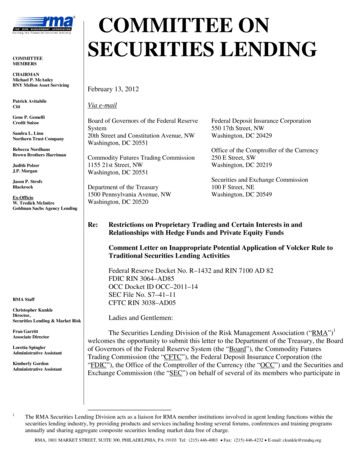
Transcription
COMMITTEEMEMBERSCHAIRMANMichael P. McAuleyBNY Mellon Asset ServicingPatrick AvitabileCitiGene P. GemelliCredit SuisseSandra L. LinnNorthern Trust CompanyRebecca NordhausBrown Brothers HarrimanJudith PolzerJ.P. MorganJason P. StrofsBlackrockEx-OfficioW. Tredick McIntireGoldman Sachs Agency LendingCOMMITTEE ONSECURITIES LENDINGFebruary 13, 2012Via e-mailBoard of Governors of the Federal ReserveSystem20th Street and Constitution Avenue, NWWashington, DC 20551Commodity Futures Trading Commission1155 21st Street, NWWashington, DC 20551Department of the Treasury1500 Pennsylvania Avenue, NWWashington, DC 20520Re:Federal Deposit Insurance Corporation550 17th Street, NWWashington, DC 20429Office of the Comptroller of the Currency250 E Street, SWWashington, DC 20219Securities and Exchange Commission100 F Street, NEWashington, DC 20549Restrictions on Proprietary Trading and Certain Interests in andRelationships with Hedge Funds and Private Equity FundsComment Letter on Inappropriate Potential Application of Volcker Rule toTraditional Securities Lending ActivitiesFederal Reserve Docket No. R–1432 and RIN 7100 AD 82FDIC RIN 3064–AD85OCC Docket ID OCC–2011–14SEC File No. S7–41–11CFTC RIN 3038–AD05RMA StaffChristopher KunkleDirector,Securities Lending & Market RiskFran GarrittAssociate DirectorLoretta SpinglerAdministrative AssistantKimberly GordonAdministrative Assistant1Ladies and Gentlemen:The Securities Lending Division of the Risk Management Association (“RMA”)1welcomes the opportunity to submit this letter to the Department of the Treasury, the Boardof Governors of the Federal Reserve System (the “Board”), the Commodity FuturesTrading Commission (the “CFTC”), the Federal Deposit Insurance Corporation (the“FDIC”), the Office of the Comptroller of the Currency (the “OCC”) and the Securities andExchange Commission (the “SEC”) on behalf of several of its members who participate inThe RMA Securities Lending Division acts as a liaison for RMA member institutions involved in agent lending functions within thesecurities lending industry, by providing products and services including hosting several forums, conferences and training programsannually and sharing aggregate composite securities lending market data free of charge.RMA, 1801 MARKET STREET, SUITE 300, PHILADELPHIA, PA 19103 Tel: (215) 446-4003 Fax: (215) 446-4232 E-mail: ckunkle@rmahq.org
February 13, 2012Page 2the securities lending industry as agent banks.2 These members include securities lending agents(“agent banks”) such as JP Morgan Chase & Co., The Bank of New York Mellon Corporation,Northern Trust Corporation and State Street Corporation, among others.Section 619 of the Dodd-Frank Act3, commonly referred to as the “Volcker Rule”,broadly limits a bank’s authority to establish funds that are exempt from investment companyregistration under Sections 3(c)(1) or (7) of the Investment Company Act of 1940 (the“Investment Company Act” and such funds, “3(c)(1)/(7) funds”). RMA is concerned that theinteragency Proposed Rulemaking4 implementing the Volcker Rule could significantly (and webelieve, inadvertently) impair the long-established securities lending activities of many of ourmembers. As drafted, the Proposal could limit our members’ ability to establish privateinvestment vehicles (“cash collateral pools”) on behalf of their securities lending clients tofacilitate the investment of such clients’ cash collateral that is derived from securities lendingtransactions. In addition, RMA is concerned that the Proposal could be interpreted to prohibitborrower default indemnification, a traditional accommodation provided to certain clients byagent banks in connection with their securities lending programs.This letter discusses why it is inappropriate for the Volcker Rule’s fund limitations toinhibit the operation of agent banks’ traditional securities lending activities, including pooledcash collateral investment and borrower default indemnification, and details some approaches toaddress these concerns.The analysis set forth in this letter supports the following conclusions: The purpose of the Volcker Rule is to restrict federally insured banks from investing theirown funds in speculative trading activity, which arguably puts banks’ own capital at riskand results in potential conflicts of interest. Congress vested the Agencies with authority to tailor the application of the Volcker Ruleto exclude activities not within its intended purview. Cash collateral pools (domestic and foreign) are not of the type of activities intended tobe limited by the Volcker Rule:2For purposes of this comment letter, we refer to the Board, the CFTC, the FDIC, the OCC and the SECcollectively as the “Agencies.”3Dodd-Frank Wall Street Reform and Consumer Protection Act, Public Law 111-203, 124 Stat. 1376 (2010)(the “Dodd-Frank Act”). Section 619 amends the Bank Holding Company Act of 1956, 12 U.S.C. § 1841 etseq. (12 U.S.C. § 1851) (the “BHC Act”) by adding a new Section 13.4Prohibitions and Restrictions on Proprietary Trading and Certain Interests in, and Relationships with, HedgeFunds and Private Equity Funds, 76 Fed. Reg. 68846 (Nov. 7, 2011) (the “Volcker Proposal” or the“Proposal”). The CFTC released a separate set of proposed rules, which largely mirror the Proposal in content,on January 13, 2012. See Prohibitions and Restrictions on Proprietary Trading and Certain Interests in, andRelationships With, Hedge Funds and Private Equity Funds, available documents/file/federalregister011112c.pdf.
February 13, 2012Page 3o Cash collateral pools do not involve investment of agent banks’ own capital or theconflicts of interest that may result from such investments; ando As customary securities lending services, cash collateral pools are a long-standing,long-regulated banking product stemming from banks’ custody, advisory and agentlending services. For a number of reasons, most significantly the overbroad definition of “covered funds”under the Volcker Proposal, agent banks may effectively be prohibited from establishingand managing bank cash collateral pools. The Agencies have the authority to remedy the inappropriate limitation on cash collateralpools by adopting any of the following approaches in the final rule text and/or preamble:o Exclusion of cash collateral pools from the definition of “covered fund” andclarification either that cash collateral pools are not construed as “banking entities”under the Proposal or that cash collateral pools are included in the securities lendingexemption from the definition of “trading account”5;o Inclusion of cash collateral pools in the “customer fund” exemption of the VolckerProposal and inclusion of the credit services that agent banks customarily provide tocash collateral pools in the “prime brokerage” exception of § 13(f) of the BHC Act(including § 13(f)(1), commonly called “Super 23A”)6; ando Exemption of cash collateral pools from the Volcker Proposal’s restrictions, includingthose under Super 23A, pursuant to the Agencies’ authority under § 13(d)(1)(J) of theBHC Act. Indemnification of borrower defaults provided to certain clients by agent banks inconnection with securities lending transactions are not prohibited under § .11(e) of theProposal, and Super 23A does not prohibit such indemnification because such serviceseither are not “covered transactions” subject to Super 23A or are exempt from Super 23Aunder the “prime brokerage” exemption.In support of these conclusions, Section I of this letter summarizes the parties to andnature of a typical securities lending transaction involving a cash collateral pool and the size ofthe market more generally. Section II then discusses the purposes of the Volcker Rule, the5Our concern here is that, because the Proposal’s definition of “banking entity” includes “Any affiliate orsubsidiary of any entity described [in the definition],” other than covered funds exempt under the customerfunds exemption in § .11 of the Proposal, cash collateral pools not exempt under § .11 that are affiliatedwith agent banks could be considered “banking entities” and thus prohibited directly from carrying out theirbuying and selling of high grade securities in accordance with lending clients’ guidelines because of theproprietary trading prohibition of the Volcker Proposal. As discussed further in Section III.A., we submit thatthe proprietary trading prohibition of the Volcker Proposal should not be applicable to cash collateral poolsgiven that no bank capital is invested and, as discussed in Section II.C., the collateral pool investments aremade by the relevant bank acting in a fiduciary capacity pursuant to lending client guidelines.6Volcker Proposal §§ .11(d), .16(a)(1).
February 13, 2012Page 4authority Congress granted to the Agencies to tailor the statute in a manner that does notpreclude traditional bank activities, such as providing securities lending services and establishingand managing cash collateral pools. Section III discusses the ways in which the substantivelimitations of the Proposal could in fact (inappropriately) prohibit agent banks from managingthese pools (Proposal Questions 6, 217 and 225 addressed). Section IV discusses the approachesidentified above and how each ensures that the Proposal’s reach is properly aligned with theintent of the Volcker Rule (Proposal Questions 217, 221, 223, 303, 307 and 316 addressed).Finally, Section V discusses the Volcker Rule’s potential for inadvertent disruption of traditionalbank securities lending activities, namely by precluding agent banks from providing borrowerdefault indemnification to lending clients that are covered by the Proposal, as well as investors insuch lending clients, and discusses why the final rule should expressly permit such activities tocontinue to occur.SUMMARY TABLE OF CONTENTSI.II.III.IV.SECURITIES LENDING AND INVESTMENTS BY AGENT BANKS OFCASH COLLATERAL POOLS: SUMMARY OF PARTIES, ACTIVITY ANDMARKET.6A.Parties to securities lending transactions and nature of activities.6B.Overview of the securities lending market. .8THE VOLCKER RULE: PURPOSE OF THE STATUTE, INTENDEDAPPLICABILITY AND REASONS WHY CASH COLLATERAL POOLSSHOULD NOT BE IMPAIRED BY THE RULEMAKING. .9A.Purposes of the Volcker Rule. .9B.Agencies’ authority, and duty, to tailor the Volcker Rule’s broadapplicability so as not to cover all 3(c)(1)/(7) funds.9C.Cash collateral pools are not activities that the Volcker Rule was intendedto prohibit, and should not be limited by the rulemaking. .14THE VOLCKER PROPOSAL: INAPPROPRIATE APPLICABILITY TO CASHCOLLATERAL POOLS.17A.Proprietary trading prohibition not applicable.18B.Covered fund prohibition.19PROPOSED RESOLUTIONS: EXCLUSION FROM “COVERED FUNDS,”CUSTOMER FUND EXEMPTION OR §13(D)(1)(J) EXEMPTION.20A.Full exemption from Volcker of cash collateral pool activities pursuant toan appropriate limitation of the definition of “covered funds.”.20
February 13, 2012Page 5V.VI.B.Customer fund exemption.26C.Exemption of cash collateral pool activities pursuant to §13(d)(1)(J)authority. .30BORROWER DEFAULT INDEMNIFICATION SERVICES PROVIDED BYAGENT BANKS TO CERTAIN CLIENTS IN CONNECTION WITHSECURITIES LENDING SERVICES SHOULD BE PERMITTED UNDER THEVOLCKER PROPOSAL. .33A.Indemnification services as customary to securities lending transactionsand separate from activities Volcker was intended to prohibit.33B.§ .11(e) of the Volcker Proposal should not be interpreted to limitindemnification services customarily provided to Lending CustomerFunds or Indemnified Client Investors. .35C.Borrower default indemnification services should not be limited by Super23A, and in any event should be exempt from any potential application ofSuper 23A under the “prime brokerage” exception.35CONCLUSION.37
February 13, 2012Page 6I.Securities lending and investments by agent banks of cash collateral pools:Summary of parties, activity and market.Securities lending transactions are a traditional bank activity that supports global capitalmarkets activities and facilitates trade settlement. By effectively increasing the supply ofsecurities available for these and other market activities, securities lending improves globalmarket liquidity and enhances price discovery.7A.Parties to securities lending transactions and nature of activities.Securities lenders largely consist of institutions such as public and private pension funds,ERISA plans, endowment funds of not-for-profit institutions, insurance companies, investmentfunds, and other similar entities or funds into which such entities invest. Borrowers in securitieslending transactions largely consist of broker-dealers, banks and other financial institutions.Through securities lending programs, agent banks act as intermediaries to facilitate loansof eligible securities by securities lenders (the clients of the agent banks, or “lending clients”) toqualified borrowers. Securities generally are lent pursuant to (i) a securities lendingauthorization agreement between the securities lender and the agent bank, and (ii) a securitiesborrowing agreement between the borrower and the agent bank. Pursuant to these agreements,the lending clients (and, directly or indirectly, the agent banks) have a security interest in andlien on the collateral, most frequently cash, provided by the borrower in an amount in excess ofthe value of the security borrowed, usually by a margin of 2% to 5% depending on certaincharacteristics of the security. These agreements also typically provide that lending clients (ortheir investors) are indemnified by the agent banks for any deficiencies in collateral in the eventof a borrower default, usually in the form of failure to return the borrowed securities, commonlyreferred to as “borrower default indemnification.”At the end of the loan, the securities lender must return to the borrower the same amountof cash collateral provided by the borrower. In periods when interest rates are more than deminimus, the securities lender pays the borrower a negotiated “loan rebate fee” on the cashcollateral received. The securities lender receives all revenues from the pool (and, as describedbelow, is responsible for all losses) that are allocated to its cash collateral invested, less theborrower’s loan rebate fee. A fee is paid to the agent bank that is generally a percentage of thelender’s net revenue from the cash collateral pool. A diagram showing the structure of a typicalsecurities lending transaction is attached as Exhibit A.A significant corollary to a securities lending transaction is the investment of cashcollateral provided by a borrower to a lending client as security for the loan. Typically, thelending client authorizes the agent bank to invest, in its discretion, the lending client’s cash7See Securities lending transactions: market development and implications, report prepared by the TechnicalCommittee of the International Organization of Securities Commissions and the Committee on Payment andSettlement Systems of the central banks of Group of Ten countries, International Organization of SecuritiesCommissions and Bank for International Settlements (July 1999), available athttp://www.bis.org/publ/cpss32.htm.
February 13, 2012Page 7collateral, within certain parameters agreed with the lending client, commonly referred to asinvestment guidelines, and in accordance with any other restrictions under the securities lendingauthorization agreement. Such cash collateral investment is performed by the agent bank for theaccount of and at the risk of the lending client.If the lending client elects, the cash collateral provided by a borrower as security for theloans attributable to such client is pooled by the agent bank with other cash collateral provided toother clients. These investment “pools” may exist in the form of trusts, partnerships, limitedliability companies, or even separate accounts maintained by more than one party (in the case ofsuch accounts, generally by related parties, such as multiple pension plans of a municipality).Because securities on loan can generally be recalled promptly by the lender, the collateralgenerally is invested in highly liquid securities. Cash collateral pools generally invest in highlyrated fixed income securities, including U.S. and non-U.S. sovereign debt, such as U.S.Treasuries, U.S. government agency securities, and foreign sovereign debt, highly ratedcorporate debt and other similar types of securities. By pooling cash collateral, agent banks areable to defray investment management and other transaction costs (including costs of borrowerdefault indemnification) for participating lending clients and afford them investmentopportunities that otherwise may not be available. As part of pooled cash collateralmanagement, agent banks have also traditionally provided short-term extensions of credit andcontractual income and settlement services to lending clients and cash collateral pools tofacilitate trade settlement and related cash collateral investment activities.8One significant impact of the Volcker Rule and the Proposal’s limitation on establishingand maintaining cash collateral pools would be to marginalize participation by many lendingclients (such as some public and private pension funds, ERISA plans and endowment funds ofnot-for-profit institutions). That is, if agent banks could no longer establish and maintain cashcollateral pools (e.g., by having to “outsource” to a third party the custody of cash collateralpools and/or the related short-term credit services provided to the pools)9, participation insecurities lending programs would only be cost effective for the largest lending clients. As aresult, many small and intermediate securities lending clients would be denied the incrementalrevenue securities lending can provide, and securities lending programs could lose significantdiversification in lending clients, lendable assets, borrowers and agent banks. Additionally, assecurities lending revenues are generally used to defray costs of custodial, advisory and otherservices offered by agent banks to lending clients, the actual costs of such custodial or otherservices provided to clients that no longer participate in lending would increase.8Contractual settlement refers to the process by which an agent bank, in order to facilitate settlement ofsecurities transactions, will credit the account of a collateral pool with proceeds due from a counterparty inanticipation of the agent bank’s receipt of those proceeds from the counterparty on the same day; the credit isprovisional and is subject to reversal if the anticipated proceeds are not received in a timely fashion.Contractual income refers to the process by which an agent bank, in order to facilitate securities transactions,will credit the account of a collateral pool with proceeds of payments that the collateral pool expects to receiveon the same day.9It should be noted that while the “outsourcing” of custody or short-term credit services provided to cashcollateral pools may seem appealing, such a strategy raises significant concerns in addition to the potentialimpacts addressed above. Importantly, concerns exist around protection of trade secrets as eligible third-partycustodians would also likely be competitor agent banks and counterparty credit risks that may conflict with theDodd-Frank Act’s efforts to reduce counterparty credit risk, e.g., Section 165 of the Dodd-Frank Act.
February 13, 2012Page 8B.Overview of the securities lending market.In the U.S. lending market, cash is taken as collateral for more than 85% of securitiesloans.10 Loans are over-collateralized by a margin of typically 2% to 5%, depending on thejurisdiction of the loaned securities’ issuance and the type of collateral provided. Cash collateralis reinvested in securities, often in pools, in both the U.S. and abroad. Indeed, because some ofthose pools are established outside the U.S. to benefit lending clients, it is critical that theregulators adjust the language of the final rule to clearly allow both U.S. and non-U.S. cashcollateral pools to be established.Securities lending and the reinvestment of cash collateral have been a customaryoutgrowth of custody, advisory and related activities for decades, and, as discussed in furtherdetail in Section II.C below, have been regulated, examined, and treated by regulators astraditional banking services for some time.As of the third quarter of 2011, about 2 trillion of securities were on loan in the globalsecurities lending market.11 RMA composite figures for the fourth quarter of 2011, compilingresponses of 13 member banks, showed 6 trillion of U.S. lendable assets and 3 trillion of nonU.S. lendable assets in the securities lending market, of which over 500 billion of U.S.securities and 170 billion of non-U.S. securities were on loan against cash collateral.12 Ifinterrupted, this could materially impair access to securities, driving down liquidity and in turnimpeding price discovery. The combined effect of such events could potentially lead to vastdisruptions in the capital markets. At a minimum, if the final regulations implementing theVolcker Rule act to restrict U.S. agent banks from establishing cash collateral pools andproviding other traditional corollary services to the pools and lending clients discussed in thisletter, U.S. agent banks could lose significant market share of non-U.S. lendable assets to nonU.S. agent banks not subject to such restrictions. Moreover, as stated above, if agent banks wereforced by an inappropriate application of the Volcker Rule to “outsource” cash collateral pools,or the related credit facilities, to other parties, it would be uneconomical for agent banks to offersecurities lending services to all but the largest lending clients.Agent banks acting as intermediaries in this activity (i.e., the RMA Members) includesome of the largest banks in the world, such as JP Morgan Chase & Co., The Bank of New YorkMellon Corporation, Northern Trust Corporation and State Street Corporation, among others. Asthe foregoing demonstrates, in establishing and operating these pools, these agent banks areengaging in a traditional, highly regulated bank activity without putting their own funds at risk,and performing a function that is critical to the U.S. (and global) economies.10See Bank of England Quarterly Bulletin 2011 Q3: Developments in the global securities lending market,available at etin/qb110303.pdf (“Bank of EnglandQuarterly Bulletin”), Chart 2 at 226.11Bank of England Quarterly Bulletin, id., at 224.12RMA Quarterly Composite Data on Securities Lending, Fourth Quarter 2011, available to the Agencies uponrequest in connection with the Agencies’ review of this Comment Letter and implementation of the VolckerRule.
February 13, 2012Page 9II.The Volcker Rule: Purpose of the statute, intended applicability and reasons whycash collateral pools should not be impaired by the rulemaking.Part A of this section sets out the purposes of the Volcker Rule according to itslegislative history and the study prepared by the Financial Stability Oversight Council (“FSOC”).Part B shows how Congress, the FSOC and the Agencies have agreed that the statute should notbe interpreted to apply to all 3(c)(1)/(7) funds, but only those entities which are of the type therule was intended to prohibit. Part C describes why cash collateral pools are not the type ofactivities the Volcker Rule was intended to prohibit and as such, on one or more of the multiplebases set forth in Section IV, should not be impaired in any way by the Proposal.A.Purposes of the Volcker Rule.Paul Volcker’s intent. In testimony to the Senate Banking Committee, Paul Volckerindicated that his major focus in crafting this provision of the Dodd-Frank Act was to limitbanks’ proprietary investment of their capital. Specifically, he stated, “Curbing the proprietaryinterests of commercial banks is in the interest of fair and open competition as well as protectingthe provision of essential financial services.”13Purposes defined by the FSOC Study. As mandated by the Volcker Rule, the FSOCcommissioned a study (the “FSOC Study”)14 setting out the following three purposes of theVolcker Rule (emphasis added):1.Separate federal support for the banking system from speculative tradingactivity with banking entities’ own capital;2.Reduce potential conflicts of interest between banking entities and theircustomers; and3.Reduce risk to banking entities and nonbank financial companiesdesignated for supervision by the Board.As the foregoing evidences, the purpose of the Volcker Rule is to restrict bankingorganizations from investing their own funds speculatively, because this type of activity bothputs banking organization capital at risk and results in potential conflicts of interest betweenbanks and their customers.B.Agencies’ authority, and duty, to tailor the Volcker Rule’s broadapplicability so as not to cover all 3(c)(1)/(7) funds.The scope of the Volcker Rule’s prohibition against bank ownership or sponsorship of“private equity funds” and “hedge funds” hinges on the definition of those terms. Finding thesetypes of entities difficult to define, legislators created an overbroad definition (i.e., using as a13S. Rept. 111-176 at 8, quoting testimony by Paul Volcker, former Federal Reserve Board Chairman andChairman of the President’s Economic Recovery Advisory Board, to the Senate Banking Committee, 2/2/10.14Financial Stability Oversight Council, Study & Recommendations on Proprietary Trading & CertainRelationships with Hedge Funds & Private Equity Funds (Jan., 2011), at 8.
February 13, 2012Page 10basis all 3(c)(1)/(7) funds) that left ambiguity as to how it should be applied by regulators.However, as this section demonstrates, Congress clearly indicated that it expected the Agenciesto use their authority to ensure that entities not intended to be restricted were not captured by theVolcker Rule’s prohibitions. The Agencies have recognized this directive, but, as furtherdiscussed in Section III, the Proposal should be revised to exclude more appropriately the typesof funds that were not intended to be covered by the broad reach of the Volcker Rule.Legislative history shows drafters intended regulators to narrow the scope of the VolckerRule’s applicability.The legislative history of the Dodd-Frank Act shows that Congress intended the VolckerRule to apply only to traditional hedge funds and private equity funds, and that regulators shoulduse their rulemaking authority to exempt other vehicles inappropriately or unintentionallycovered by the overbroad definition of “private equity funds” and “hedge funds” as 3(c)(1)/(7)funds. Several congressional colloquies evidence this intent.For example, Representative Jim Himes (D-CT) pointed out that this definition “couldtechnically apply to lots of corporate structures, and not just the hedge funds and privateequity funds.” When Representative Himes specifically asked for confirmation that the VolckerRule wouldn’t deem subsidiaries or joint ventures used by firms to hold other investments to behedge funds or private equity funds under the Volcker Rule, House Financial Services ChairmanBarney Frank (D-MA) responded “ We do not want these overdone. We don’t want there to beexcessive regulation. And the distinction the gentleman draws is very much in this bill, and weare confident that the regulators will appreciate that distinction, maintain it, and we will bethere to make sure that they do.”15Furthermore, Representative Anna Eshoo (D-CA) also indicated that the Agencies shouldnarrow the statutory definition by her statement, “I expect the regulators to use the broadauthority in the Volcker Rule wisely and clarify that funds that invest in technology startupcompanies, such as venture capital funds, are not captured under the Volcker Rule and falloutside the definition of ‘private equity funds’.”16Similarly, Senator Barbara Boxer (D-CA) sought confirmation that the intent of the ruleis not to harm venture capital investment. Senate Banking Committee Chairman ChristopherDodd (D-CT) responded by stating that “. . . [P]roperly conducted venture capital investmentwill not cause the harms at which the Volcker rule is directed. In the event that properlyconducted venture capital investment is excessively restricted by the provisions of section 619, Iwould expect the appropriate Federal regulators to exempt it using their authority undersection 619[d][1](J).”1715Colloquy Between Senate Banking Committee Chairman Christopher Dodd and Senator Barbara Boxer, 156Cong. Rec. S5904 (daily ed. July 15, 2010).16156 Cong. Rec. E1295 (daily ed. July 23, 2010) (emphasis added).17Colloquy Between House Financial Services Chairman Barney Frank and Representative Jim Himes, 156Cong. Rec. H5226 (daily ed. June 30, 2010) (emphasis a
1 The RMA Securities Lending Division acts as a liaison for RMA member institutions involved in agent lending functions within the securities lending industry, by providing products and services including hosting several forums, conferences and training programs annually and sharing aggregate composite securities lending market data free of charge.
